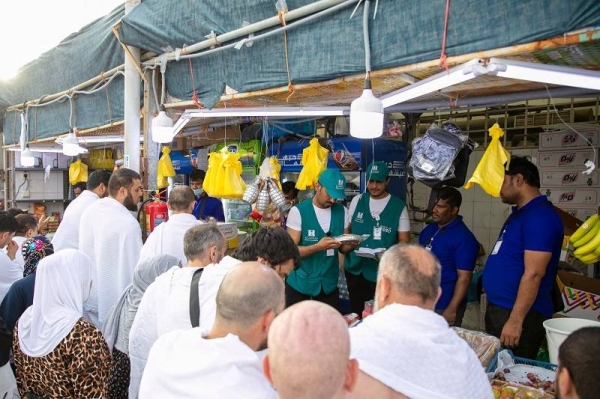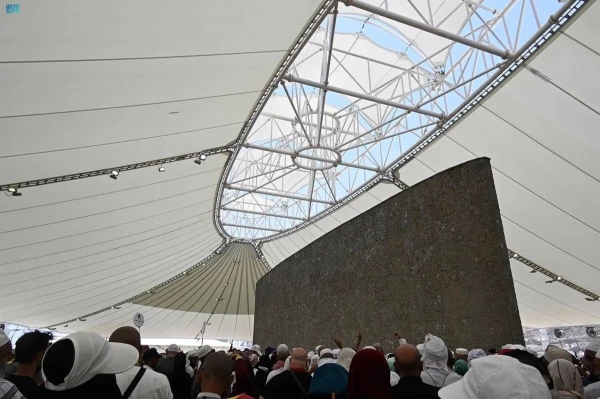
MINA — Pilgrims threw pebbles at all three Jamarat or pillars symbolizing Satan, on Wednesday, the first day of Tashreeq, and the fourth day of the annual pilgrimage of Hajj.
Wearing face masks and their normal dress after exiting from ihram on Tuesday, pilgrims moved in batches in an orderly and smooth manner while maintaining physical distancing.
On their arrival at the Jamarat, pilgrims, chanting “Allahu Akbar” (God is the greatest), stoned first at Jamarat Al-Sugra (small pillar), then at Jamarat Al-Wusta (medium pillar) and lastly at Jamarat Al-Aqaba (largest pillar) seven times each.
The pilgrims moved easily and comfortably from one pillar to the next as they hurled pebbles at the pillars. They prayed after stoning the first two pillars and quit quickly after stoning at the third Jamarat, following the tradition of the Prophet (peace be upon him).
In total compliance with the coronavirus preventive protocols during this year’s exceptional Hajj, around 60,000 men and women domestic pilgrims hailing from 150 nationalities proceeded from their camps in Mina to the Jamarat Complex on their scheduled time this afternoon.
The ritual began on Tuesday by stoning only at Jamarat Al-Aqaba. A huge contingent of security forces and health workers were deployed at the Jamarat Complex to ensure the safety and health of the pilgrims as well as their smooth conduct of the stoning ritual.
Stoning at Jamarat is the most repeated ritual of the Hajj. Pilgrims perform the ritual at one Jamarat (Jamarat Al-Aqaba) on the first day of stoning on the Day of Sacrifice, Dhul Hijjah 10. In the next two or three days, they hurl seven stones each at the three pillars.
The five-level Jamarat Complex structure around the three stoning sites allows for a smooth flow of pilgrims who are only permitted to move in one direction throughout the area to prevent congestion.
After performing four main rituals of stoning, sacrificing animals, shaving or cutting hair and performing Tawaf Al-Ifadah and sai’ on Tuesday, pilgrims returned to their accommodation in Mina.
After Wednesday’s ritual of stoning, they will spend the rest of the time in prayers and supplications in their tents, and the five-day rituals of Hajj will come to a close after performing stoning rituals at Jamarat on Thursday afternoon.
In a related development, the General Presidency for the Affairs of the Two Holy Mosques distributed 50,000 umbrellas to pilgrims and those serving the pilgrims in the Grand Mosque, as part of its initiative titled “Your Umbrella is in Your Hands.”
The initiative aims to protect the pilgrims from the heat of the sun during their performance of the Tawaf al-Ifadah, as well as the presidency employees, security personnel, health workers, and volunteers inside the Grand Mosque and its courtyards.
This initiative is one of the programs of the presidency’s campaign, with the theme of “Serving the Pilgrim and Visitor is a medal of honor for us”, which aims to offer several initiatives and programs to provide the finest and best services to the pilgrims.
Meanwhile, Janadi Madkhali, director of the General Department of Social Services at the presidency, said that the General Secretariat for Islamic Awareness at the Ministry of Islamic Affairs, Call and Guidance has completed the first phase of its awareness and guiding plan for the Hajj of 2021.
The first phase of the plan included disseminating 900,000 text messages through telecom operators, along with cards and awareness clips on 62 electronic screens in the Namira and Al-Masharul Haram mosques at the holy sites in ten international languages.
He said the second phase of the plan, which began on Wednesday and continues until the departure of the pilgrims, aims to broadcast 500,000 text messages to the phones of pilgrims and continue implementing advocacy programs at the campaign headquarters and across the ministry’s digital platforms and satellite channels, emphasizing the adoption of precautionary measures to stem the spread of coronavirus.











